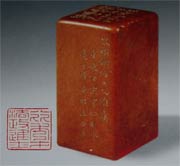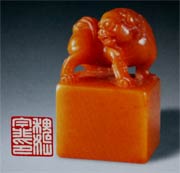The Art of Chinese Chop (Seal Carving)
The Chinese Chop Art (or seal carving) is one of the traditional four arts, i.e., Chinese painting, calligraphy, poetry and seal carving. A personal chop in red color is an integrated part of a Chinese artwork of painting or calligraphy, which is not only the signature of the artist on the artwork, but also an essential touch to liven it up.
 A typical seal is usually carved on a small block of stone using a special knife according to a calligraphy written on it. The material used for carving can be stone, crystal, jade, metal, ivory, wood, rubber, etc. But stone is still the preferred material for seal carving and the most valuable and famous stones for seal carving are Changhua, Qingtian, Shoushan and Balin stones in China. The seal on the left is made from a Shoushan stone.
A typical seal is usually carved on a small block of stone using a special knife according to a calligraphy written on it. The material used for carving can be stone, crystal, jade, metal, ivory, wood, rubber, etc. But stone is still the preferred material for seal carving and the most valuable and famous stones for seal carving are Changhua, Qingtian, Shoushan and Balin stones in China. The seal on the left is made from a Shoushan stone.
 The Chinese characters carved on a chop can be either in relief (called Yang or male) or into the stone (called Yin or female or intaglio). The lion seal on the left is made from one of the best stones, called Tianhuang, also from Shoushan. Both the stone and the carving are remarkable. It is an intaglio seal.
The Chinese characters carved on a chop can be either in relief (called Yang or male) or into the stone (called Yin or female or intaglio). The lion seal on the left is made from one of the best stones, called Tianhuang, also from Shoushan. Both the stone and the carving are remarkable. It is an intaglio seal.
 The seal carving is an ancient art. The stamp on the left is from one of the three seals, found in Anyang, the ancient capital of the Shang Dynasty (1600 BC - 1046 BC). Though it is uncertain if the three seals are from the Shang Dynasty, they are certainly the earliest seals ever found in China. Seals became practical and popular during the Warring States (475 BC - 221 BC). And more importantly seals have gradually become an indispensable item for signing important legal documents since then. An official seal represents the office and the power. Seals were matured and flourished in the Han Dynasty (206 BC - 220). The function of seals also changed over the dynasties. Some seals were still created for their practical functions, but some seals were created purely as works of art. Of course there were seals created to serve both purposes.
The seal carving is an ancient art. The stamp on the left is from one of the three seals, found in Anyang, the ancient capital of the Shang Dynasty (1600 BC - 1046 BC). Though it is uncertain if the three seals are from the Shang Dynasty, they are certainly the earliest seals ever found in China. Seals became practical and popular during the Warring States (475 BC - 221 BC). And more importantly seals have gradually become an indispensable item for signing important legal documents since then. An official seal represents the office and the power. Seals were matured and flourished in the Han Dynasty (206 BC - 220). The function of seals also changed over the dynasties. Some seals were still created for their practical functions, but some seals were created purely as works of art. Of course there were seals created to serve both purposes.
The seal carving is closely associated with Chinese writing. After all, most seals have Chinese characters on them. Chinese characters have developed many different scripts or styles over the long Chinese history, which are reflected on seals as well. On the other hand, the Chinese characters on seals are often not the exact copies of those in writing since they need to fit the small seals. For example, the Xiaozhuan script developed during the Qin Dynasty (221 BC- 207 BC) was usually not carved on seals exactly. The Xiaozhuan script is relatively round in shape, but a seal is usually square in shape. Thus to make it fit or look balanced, the Xiaozhuan script was often normalized on seals, which became more even and squared. This in turn promoted the development of Chinese writing.
Traditional Chinese stamps are quite versatile. Typically there are name stamps, words or phrase stamps, official stamps, and picture stamps. The content of the stamps could be anything, such as a favorite word, a motto, a name of an object or a thing, etc. The carving style of the stamps varies greatly as well, which depends on mainly two factors, the script used and the expression of the artist. As we know, there are a range of Chinese scripts, even though zhuan or seal script is the most commonly used. The carving of the artist could be plain or abstract so the carving could be quite different even with the same script.
Today, seals are still playing an important role in the daily life of Chinese people. They are required for signing important documents, such as the documents for buying a house. Red stamps are seen in all official documents. Without the red stamps on the papers, not much you can do in China. If you have been in China, you have probably seen the red custom stamps in your passport.
Red is the color of a Chinese stamp. Red is the luckiest color for the Chinese. And red color strikes the eyes on an artwork or a paper so it stands for the importance of the stamp, particularly considering the small size of a stamp.
The seal carving as an art is still much appreciated by many people. The prices of some rare seals have skyrocketed in recent years in China.
To appreciate the ancient art, we now offer personal stamps created with our expertise in Chinese culture and Chinese names. Check out the following:


